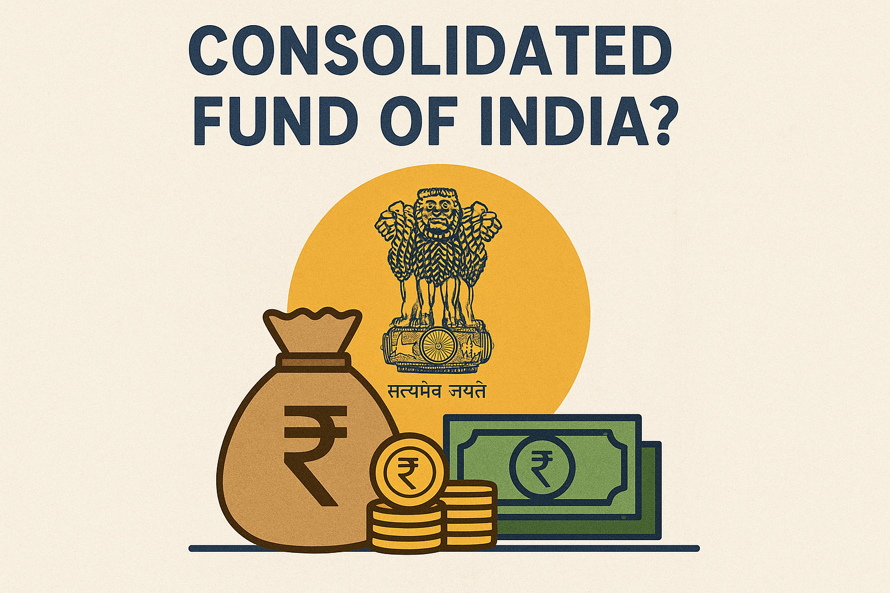
The Indian government has a well-structured system in place for handling the funds allotted for revenue and capital expenditures. The Consolidated Fund, the Contingency Fund, and the Public Account are the three primary divisions of its financial accounts. The Consolidated Fund of India is the principal account for all government income, which includes taxes, loans, and other receipts. In fact, it is the source of funding for all government expenditures.
It simply makes sure that all public expenditure is correctly accounted for and managed by the government. This blog post provides detailed information about the Consolidated Fund of India.
Introduction to the Consolidated Fund of India
The Consolidated Fund of India (CFI) is a crucial component of India’s public finance system. Article 266(1) of the Constitution made it the government’s primary bank account, where all revenue, including taxes, fees, borrowing, and loan repayments, is deposited.
The Consolidated Fund is a repository of all of the government’s expenditures, from building infrastructure to paying salaries. Also, the central organization ensures fiscal discipline, transparency, and democratic accountability.
What does the Consolidated Fund of India mean?
Essentially, the Consolidated Fund of India serves as the government of India’s leading financial clearinghouse. It includes all amounts received from loans, repayments, and statutory income. This account releases money only after parliamentary approval for each demand in a functioning democracy. Besides, this process prevents arbitrary expenditure and ensures legislative monitoring. Through established checks and balances, this system upholds constitutional values and guarantees public confidence.
Why is it important?
Because it provides a transparent and traceable framework for the government’s whole financial infrastructure, the CFI is essential. In order to minimize the abuse of public funds, every legislative approval to withdraw from it is subject to close inspection. Additionally, the government may more effectively plan and strategically allocate spending by combining all available funds into a single fund, which would strengthen macroeconomic stability.
Components of the Consolidated Fund of India
The CFI’s organization is complex and well-thought-out, so it can handle different types of public funding. Additionally, the structure enables efficient tracking, allocation, and regulation of revenues from various sources nationwide. This ensures the accurate classification of income and expenditures, enhancing transparency and facilitating effective financial decision-making processes.
What types of money are included in this fund?
There are many sources of funding for the Consolidated Fund of India. Indirect taxes include the Goods and Services Tax (GST) and customs duty, while direct taxes encompass income tax and corporation tax. The capital portion interweaves non-tax earnings, including fees, licenses, and profits from Public Sector Undertakings, along with disinvestment proceeds, loan receipts, and repayments. It thereby covers both one-time capital inputs and continuous income.
How does it differ from other government funds?
The CFI serves as the primary source of regular government spending. The Public Account includes fiduciary accounts, such as the Provident Fund, while the Contingency Fund serves as a reserve for emergencies, and the President of India can access it without prior permission. To ensure that all essential costs receive democratic authorization, each withdrawal must be submitted through the Appropriations Bill in the Budget. Besides, this process requires approval from Parliament.
How Does the Consolidated Fund of India Work?
As the primary financial account for the government, the Consolidated Fund of India oversees all income and expenditures. It uses constitutional processes and stringent legislative supervision to guarantee accountability and transparency.
Who manages this fund?
The Ministry of Finance is responsible for managing the Consolidated Fund, but Parliament has the final say. Besides, the Comptroller & Auditor-General of India keeps an eye on the accuracy and efficiency of financial transactions. The Controller General of Accounts, which maintains meticulous classification and record-keeping, ensures further accountability.
How is money credited and spent?
The CFI receives money from a variety of sources, including dividends, borrowings, tax, and non-tax revenues. On the other hand, there are two categories of drains. The first includes charged expenditures, which are mandated by the Constitution, such as interest on the national debt, judicial pensions, and the salaries of high constitutional functionaries. The second category consists of voted expenditures, which Parliament approves annually based on departmental requests. These later items must be included in the budget even if they are not up for vote.
Role of Parliament in the Consolidated Fund of India
The Consolidated Fund of India falls under the crucial oversight of Parliament. This process prevents any money from being withdrawn without proper authorization, ensuring transparency and democratic control over public finances.
Why does Parliament control the fund?
Parliament uses the CFI as its financial instrument. All revenue goes to this central fund, so only Parliament—representing the people—can authorize its spending. This arrangement establishes democratic oversight in financial matters and stops executive overreach. Besides, to maintain democratic decision-making and financial accountability, Parliament makes use of the Consolidated Fund of India. All revenues flow in here, so only Parliament approves spending, which prevents misuse by the executive branch.
What is the approval process for expenses?
Every financial year, the government presents its budget, the annual financial statement. The Demand for Grants includes voted expenditure and charged expenditure items. Parliament actively debates and votes on these demands. The Appropriation Act is passed after approval, granting legal authority to withdraw funds. Besides, request supplementary grants mid-year if actual spending exceeds initial estimates.
Examples of Expenditure from the Consolidated Fund
The Consolidated Fund of India finances various government expenses. Administrative costs, defense, interest payments, and welfare schemes all require prior approval by Parliament. Besides, every significant expenditure receives monitoring, debate, and alignment with national priorities and policies.
What kinds of government expenses come from this fund?
The Consolidated Fund of India meets a wide range of obligations, making it vital to government spending. It includes administrative expenses such as the salaries of the President and Parliament officials, judicial payments like judges’ pensions, and significant allocations for defense and internal security. Public welfare schemes in health, education, and infrastructure receive financing from it. Besides, the fund manages interest payments on public debt and loan servicing.
How does it impact the country’s finances?
The CFI channel resources support national development and enhance service delivery. The government stabilizes the macro economy, fortifies social infrastructure, and signals fiscal responsibility by managing allocations across major sectors, like defense, rural development, and debt servicing. Besides, overspending or underestimating inflows leads to fiscal distortion and elevated debt, highlighting the need for prudent budgeting.
Importance and Impact of the Consolidated Fund on the Economy
The Consolidated Fund of India shapes the nation’s economic stability. It allocates resources efficiently, supports development goals, and maintains transparency in public financial management. It reinforces investor confidence and fiscal discipline by ensuring that government spending remains lawful and accountable.
How does this fund affect economic stability?
CFI promotes sound financial management. It helps the government to make smart investments, manage fiscal deficit, and shape macroeconomic policies. Clear transactions foster confidence in investors and help maintain economic stability. Additionally, if a financial shock occurs, funds may be allocated to countercyclical initiatives with government approval.
What happens if the fund is mismanaged?
Mismanagement of the CFI—whether through unapproved spending, fiscal leaks, or diversion of funds—destroys accountability. In addition to these issues, it increases the deficit and debt, and erodes market confidence. Reduced scrutiny means an increased risk of corruption and misuse of resources. Every time in history, when this form of unbudgeted spending has happened, it has reflected the importance of legislative scrutiny in a process designed to protect the integrity of public finances.
Conclusion
The Consolidated Fund of India centrally houses all government resources and serves as the authorized entry point for public spending. Besides, it represents legislative oversight, accountability, and budgetary restraint. Parliament must approve all expenditure proposals, ensuring democratic control over the country’s finances. Its efficacy comes not only from its size but also from the trust it builds through openness and constitutional integrity.
FAQs
Q. Is the Consolidated Fund of India the same as the Public Account?
No. The Public Account holds money with the government acting as trustee, such as provident fund contributions or postal deposits. These require repayment and do not need parliamentary approval for withdrawal, unlike the CFI.
Q. Can the government spend money without the Consolidated Fund?
Only after Parliament’s approval does routine and discretionary spending occur through the CFI. Urgent spending occurs under the Contingency Fund, which is later replenished through the CFI, or transactions happen under the Public Account as exceptions.
Q. How does it relate to the Union Budget?
The Union Budget outlines the planned statement of receipts and expenditures that the Consolidated Fund of India will manage. Besides, no money can be legally spent from the CFI without the Budget and subsequent Appropriation Act.
Q. What is the Consolidated Fund of India in simple terms?
The Indian government’s central bank account acts as the hub for all incoming funds, and Parliament must authorize every rupee spent. This ensures that public money is used responsibly, in accordance with constitutional procedures and democratic oversight mechanisms.
Q. Who can withdraw money from the Consolidated Fund of India?
The government carries out withdrawals after the Parliament has passed the Budget and authorized the respective demands. The Appropriation Act provides legal authority for withdrawals. Additionally, this process promotes accountability and transparency and protects against unauthorized withdrawals from the Consolidated Fund of India.
Q. How is the Consolidated Fund different from the Contingency Fund?
The executive can immediately access the Contingency Fund, which serves as a standby reserve for emergencies. Besides, all expenditures from it require subsequent approval and transfer from the Consolidated Fund of India.
Q. Why does the government maintain a Consolidated Fund?
It centralizes all government revenue and spending under parliamentary control. This approach ensures accountability, transparency, and systematic resource allocation. This system strengthens democratic governance and builds public trust in the nation’s financial management processes.
Q. Does the Consolidated Fund include state government money?
No. Each state has its own Consolidated Fund that adheres to the same constitutional model. The Union maintains a separation between its funds and those of the states. This separation provides financial autonomy, allowing states to manage their resources according to regional priorities and needs.




